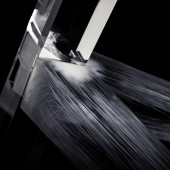DESIGN NAME:
Interlocking Table
PRIMARY FUNCTION:
Coffee Table
INSPIRATION:
The Interlocking Table presents a contemporary interpretation of traditional interlocking timber joints. Interlocking joinery, employed in various areas from furniture design to building construction, creatively exploits both material and geometry. As such, the design of novel details requires the understanding of the material, its structural performance, unique artisan techniques of fabrication, geometrically intricate assembly procedures, and innate aesthetical qualities.
UNIQUE PROPERTIES / PROJECT DESCRIPTION:
This small coffee table is composed of 5 elements with interlocking joints. The cantilevering composition of the table creatively utilizes both geometry and material to withstand structural loads. The two most notable table legs are fully printed using Multi-Material 3D printing technology. The wood grain-like pattern in the legs represents the optimal grain orientation, while its fitting is ensured by a material composition inspired by the wood scarfing technique.
OPERATION / FLOW / INTERACTION:
The table can be assembled and disassembled by simple linear motions. As such the packaging and storage require less space and the transparent quality of the table provides delicate and sculptural quality.
PROJECT DURATION AND LOCATION:
The project started and completed in 2016 and was exhibited at the Singapore National Design Center as a part of Evolving Joinery exhibition from Dec 2016-Jan 2017. (Solo exhibition of our research lab)
|
PRODUCTION / REALIZATION TECHNOLOGY:
The table top and middle leg (clear): CNC milled acrylic.
The two table legs with the wood grain-like 3D pattern and Cap: multi-material 3D printed polymers.
SPECIFICATIONS / TECHNICAL PROPERTIES:
569mm x 460mm x 468mm
TAGS:
Coffee Table, Multi-material Additive Manufacturing, CNC milling,Functionally Graded Materials
RESEARCH ABSTRACT:
The Interlocking Table was designed as a part of an academic research project. It presents a contemporary interpretation of traditional interlocking timber joints. Interlocking joinery, employed in various areas from furniture design to building construction, creatively exploits both material and geometry and hence, doing away the need for extraneous mechanical fasteners, such as bolts or screws. As such, the design of novel details requires the understanding of timber as a natural composite material and all that it entails: its characteristics of varied structural performance, unique artisan techniques of fabrication, geometrically intricate assembly procedures, and innate aesthetical qualities. With digital information technologies, namely computer-assisted structural design in combination with digital fabrication processes such as Computer Numerical Control (CNC) machining and Multi-Material 3D printing, these enable the conception and physical manifestation of interlocking structural joints which were formerly unattainable by hand-crafted timber.
Our research, funded by the SUTD-MIT International Design Centre and the SUTD Digital Manufacturing and Design Centre of the Singapore University of Technology and Design, presents insights into the traditional forms of design and its evolution into findings of new perspectives for the future.
CHALLENGE:
Our research takes a view that microstructure and its composition of every material, including that of wood, will be designed and custom-tailored to improve its performance and reliability in the near future. These materials are called Functionally Graded Materials (FGM) and one of the methods to materialize such concepts is accessible today through Multi-Material Additive Manufacturing (MMAM) technology.
As there is no material design paradigm in the current CAD tools, we developed custom tools to integrate, geometry, structural simulation, and multi-material 3D printing technology.
ADDED DATE:
2017-02-28 14:23:26
TEAM MEMBERS (6) :
Sawako Kaijima, Lee Tat Lin, Eugene Kosgoron, Amir Sakhaei, Zack Conti and Martin Dunn
IMAGE CREDITS:
Jansen Teo Photography, SUTD
PATENTS/COPYRIGHTS:
Copyrights belong to Sawako Kaijima, 2016
|









